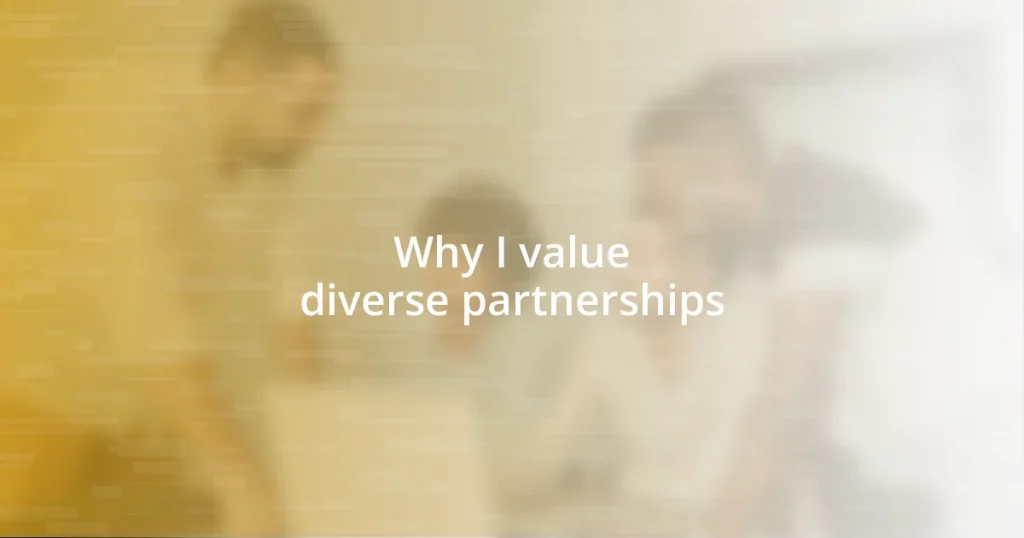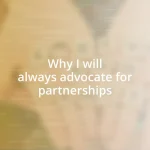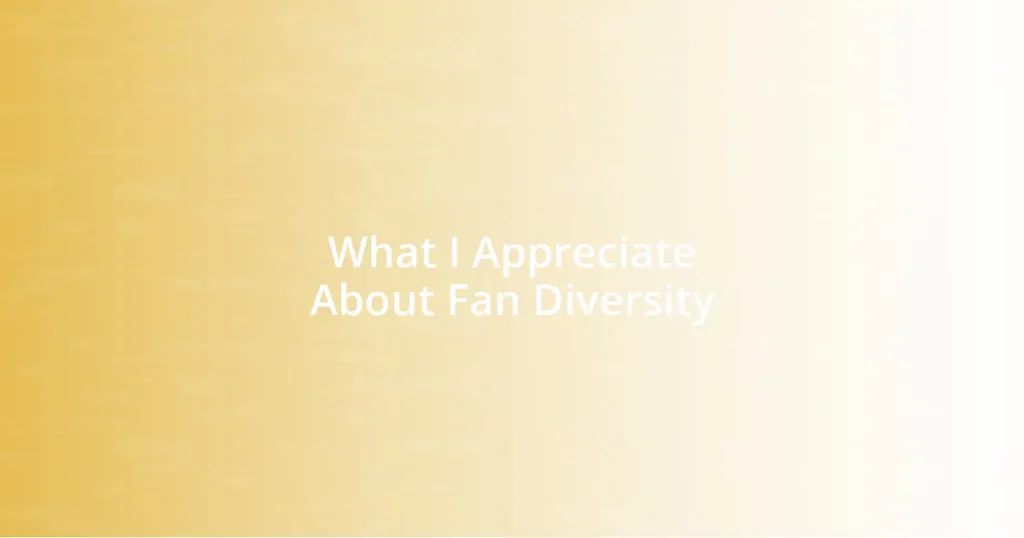Key takeaways:
- Diverse partnerships enhance creativity and problem-solving by bringing together unique perspectives and experiences.
- Challenges such as communication barriers and biases can hinder collaboration but can be overcome through patience, adaptation, and fostering an inclusive environment.
- Future trends in diverse partnerships will emphasize technology-driven collaborations, social impact, and holistic measures of success beyond traditional metrics.
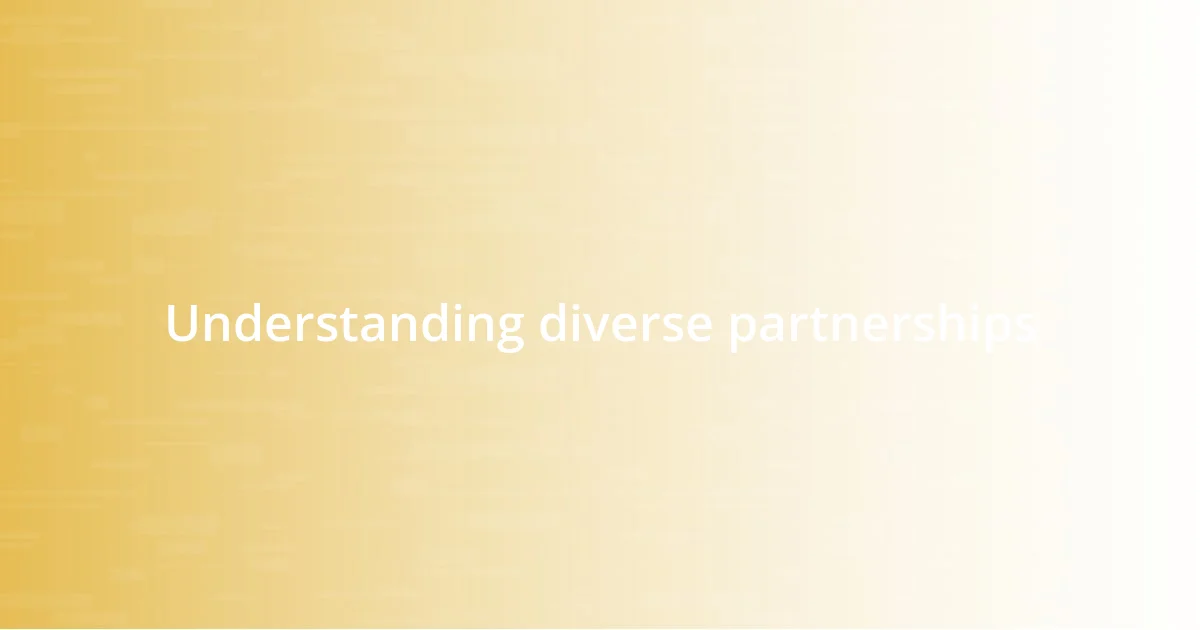
Understanding diverse partnerships
Diverse partnerships can take many forms, encompassing differences in culture, experience, and perspective. I vividly recall a project where I collaborated with individuals from various backgrounds. Each team member brought unique ideas that not only enriched our discussions but also led to innovative solutions we wouldn’t have achieved alone.
Have you ever found yourself in a situation where a fresh perspective revolutionized your thinking? That’s the beauty of diverse partnerships—they challenge our assumptions and encourage growth. Through my experience, I’ve seen how these collaborations foster a deeper understanding of complex issues and broaden our worldview, paving the way for more comprehensive solutions.
In exploring diverse partnerships, it’s crucial to recognize the power of inclusion. I remember attending a brainstorming session where divergent viewpoints sparked heated debates. Those moments of discomfort ultimately transformed into breakthroughs, highlighting that embracing differences can lead to creativity and unanticipated success. Isn’t it fascinating how our differences can become our greatest asset?
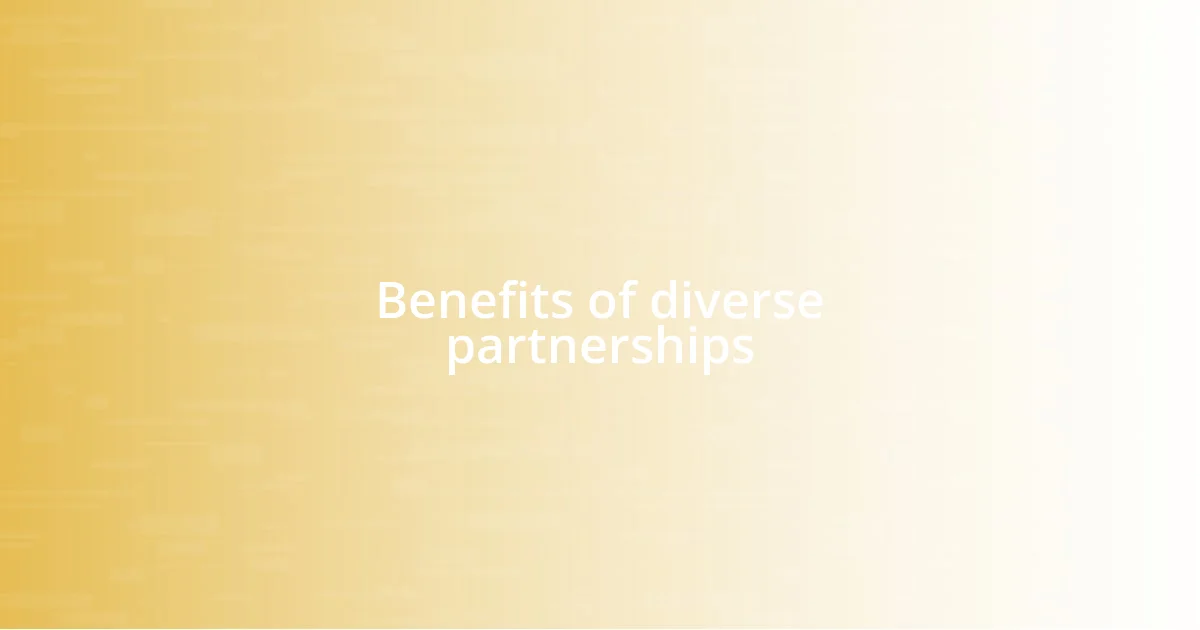
Benefits of diverse partnerships
Diverse partnerships bring a wealth of benefits that extend beyond mere collaboration. From my experience, one key advantage is enhanced creativity. I recall working with a team that included members from different disciplines—artists, engineers, and marketers. Each person approached problems from unique angles, resulting in unexpected and innovative ideas that we wouldn’t have conceived using a homogenous group.
Here are some notable benefits of diverse partnerships:
– Broadened Perspectives: Exposure to various viewpoints helps challenge biases and expands our understanding of issues.
– Improved Problem-Solving: A mix of backgrounds can lead to more effective solutions by incorporating multiple angles of analysis.
– Increased Adaptability: Diverse teams often excel in navigating change and uncertainty due to their varied experiences.
– Better Decision-Making: Teams with diverse members tend to consider more options and make more informed decisions.
– Stronger Outcomes: Combining unique strengths often results in higher quality work and more satisfying results.
The beauty of these partnerships is that they often extend beyond professional gains. In one instance, I found myself sharing a meal with a colleague whose cultural traditions and culinary skills introduced me to a new world of flavors and customs. Those moments of connection not only strengthened our project but also forged friendships that enriched both our lives. That kind of meaningful exchange is something I cherish and believe occurs more frequently within diverse teams.
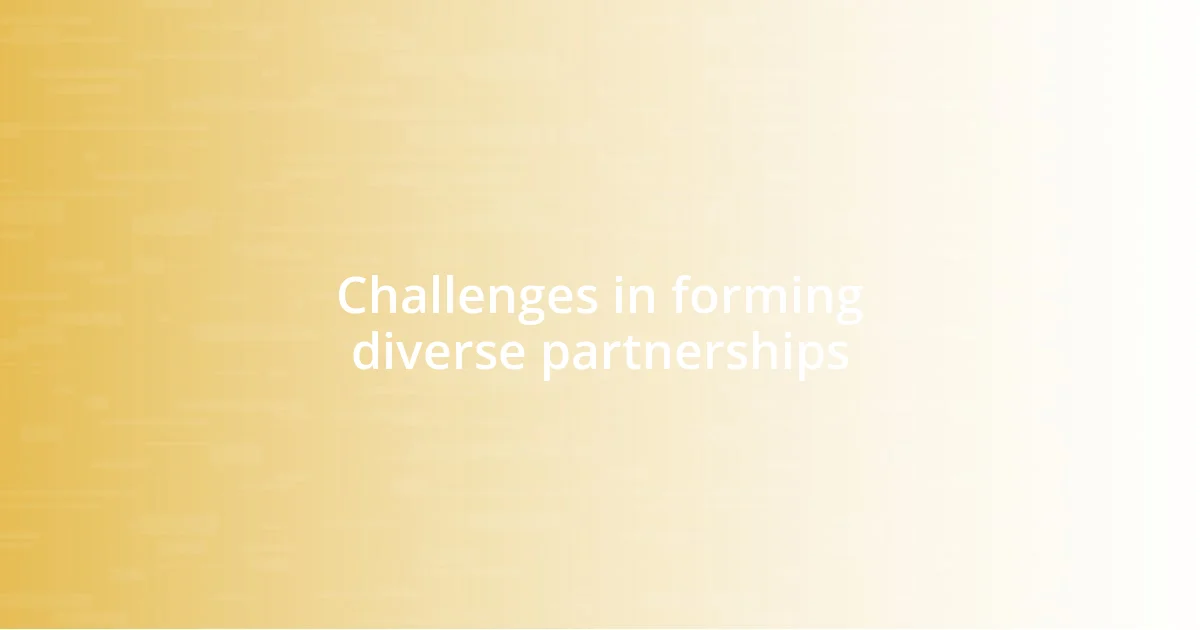
Challenges in forming diverse partnerships
Forming diverse partnerships can often be fraught with challenges, despite the many advantages they bring. One prominent difficulty lies in communication. I recall a project where I struggled to convey ideas to team members who spoke different languages. It was frustrating, but it forced me to adapt my approach and find common ground. Those moments taught me the importance of patience and clarity.
Another challenge I encountered was managing differing expectations and work styles. In one collaboration, I worked with a colleague who was meticulous and detail-oriented, while I tended to be more spontaneous in my approach. Initially, this clash created tension. However, over time, we learned to appreciate our differences, combining our styles to create a rhythm that worked for both of us. It’s a reminder that navigating these differences can lead to a stronger partnership.
Lastly, biases and preconceived notions can also hinder the formation of diverse partnerships. I remember joining a mixed group where some members held stereotypes about others’ capabilities based on their backgrounds. It took conscious effort from all of us to create an environment of trust where everyone felt valued. Only then did we unlock the full potential of our diverse inputs. Recognizing our biases is the first step toward truly embracing diversity.
| Challenge | Description |
|---|---|
| Communication Barriers | Different languages and cultural expressions can lead to misunderstandings and frustration. |
| Work Style Differences | Diverse approaches to work can create tension but also opportunities for growth. |
| Biases and Preconceived Notions | Stereotypes can hinder collaboration but recognizing them fosters trust. |
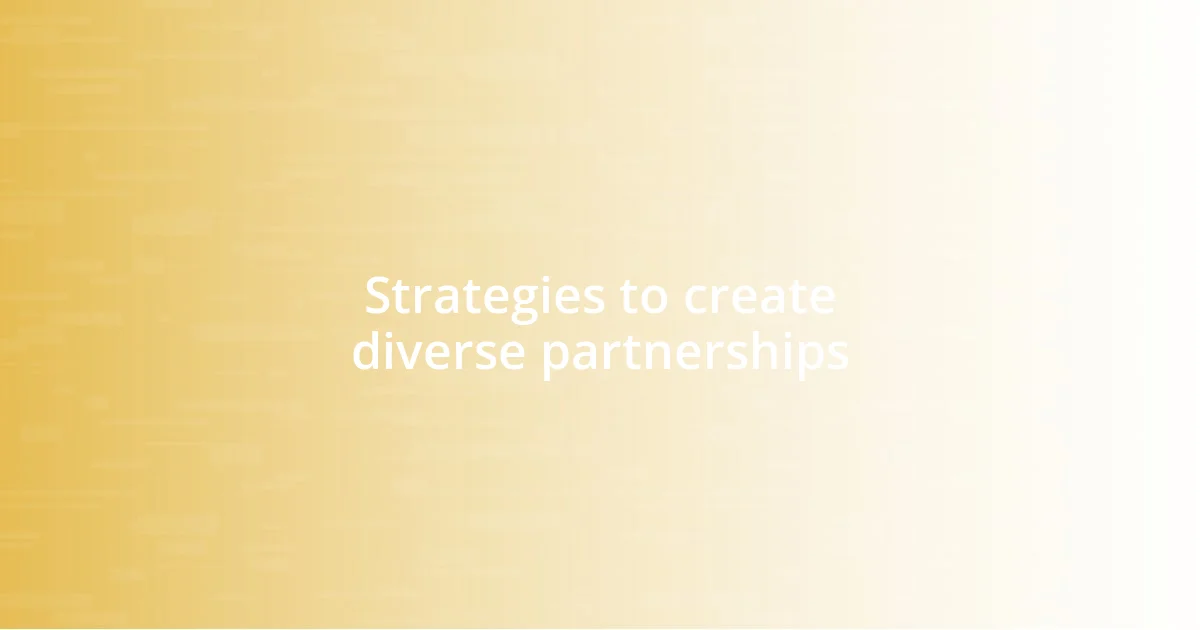
Strategies to create diverse partnerships
One effective strategy for creating diverse partnerships is to actively seek out individuals from different backgrounds and experiences. I once reached out to local community groups while searching for project collaborators. Engaging with people outside my regular networks was eye-opening; it not only broadened my understanding of various community needs but also allowed me to form connections that were both authentic and productive. When was the last time you stepped out of your comfort zone to meet someone new?
Another approach is to establish a structured yet flexible communication framework that invites everyone to express their ideas. I discovered this during a brainstorming session, where I encouraged team members to share their thoughts using sticky notes anonymously. This method alleviated some pressure, allowing quieter voices to shine. Have you ever noticed how different formats can help bring out the best in your team?
Finally, fostering an inclusive environment where all contributions are valued is essential. I remember being part of a team that held regular reflection sessions, which encouraged us to reflect on our collaborative journey. These discussions helped build trust and reinforced the idea that every voice matters. In what ways can you inspire that sense of belonging in your partnerships?
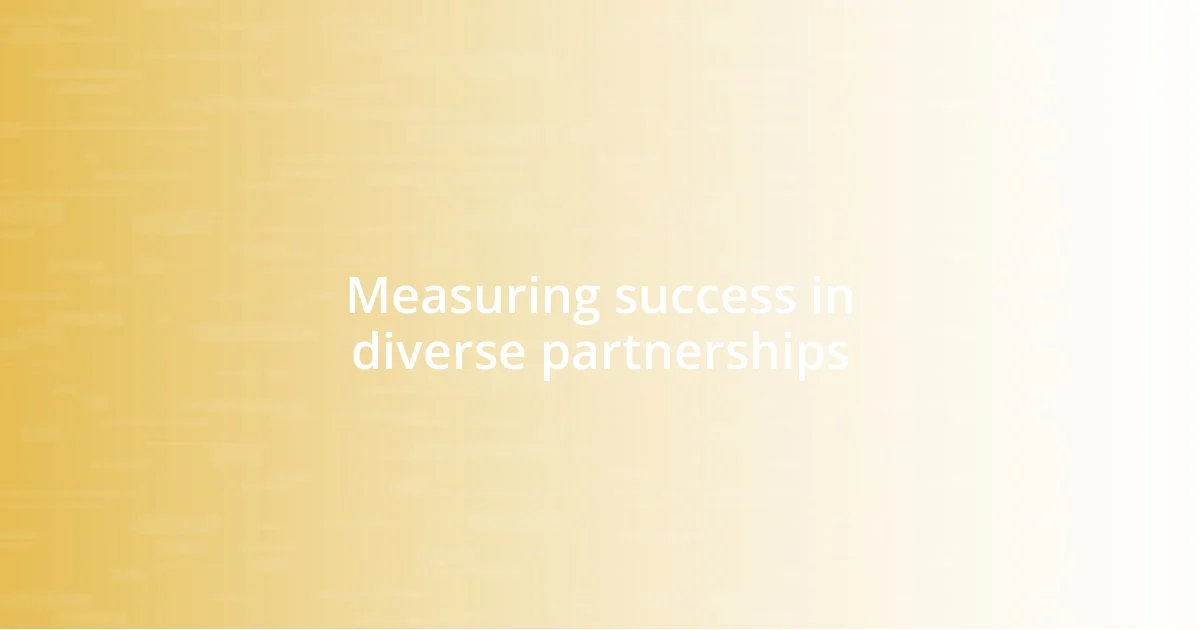
Measuring success in diverse partnerships
Measuring the success of diverse partnerships often involves looking beyond traditional metrics like profit margins. During a collaboration for a non-profit initiative, we decided to assess our impact based on community engagement and feedback instead. Not only did we create a project that resonated more deeply with the people we aimed to serve, but we also felt a profound sense of accomplishment as we witnessed the positive change firsthand. Have you ever paused to consider how success can be defined by the people it touches?
Another key factor in evaluating these partnerships is the level of innovation they inspire. I remember a project where the diversity of thought led to groundbreaking ideas that none of us would have conceived alone. Our brainstorming sessions were electric, filled with passion and creativity, and ultimately, we developed a solution that shed light on an issue that had long been overlooked. It’s a vivid reminder of how diversity can be a powerful catalyst for creative solutions, wouldn’t you agree?
Lastly, the strength of relationships built through these partnerships is a compelling success indicator. I once participated in a long-term collaboration where trust and mutual respect cultivated a sense of camaraderie. This synergy not only enhanced our teamwork but also enabled us to tackle challenges more effectively together. When you think about your own partnerships, how often do you reflect on the bonds you’ve created?
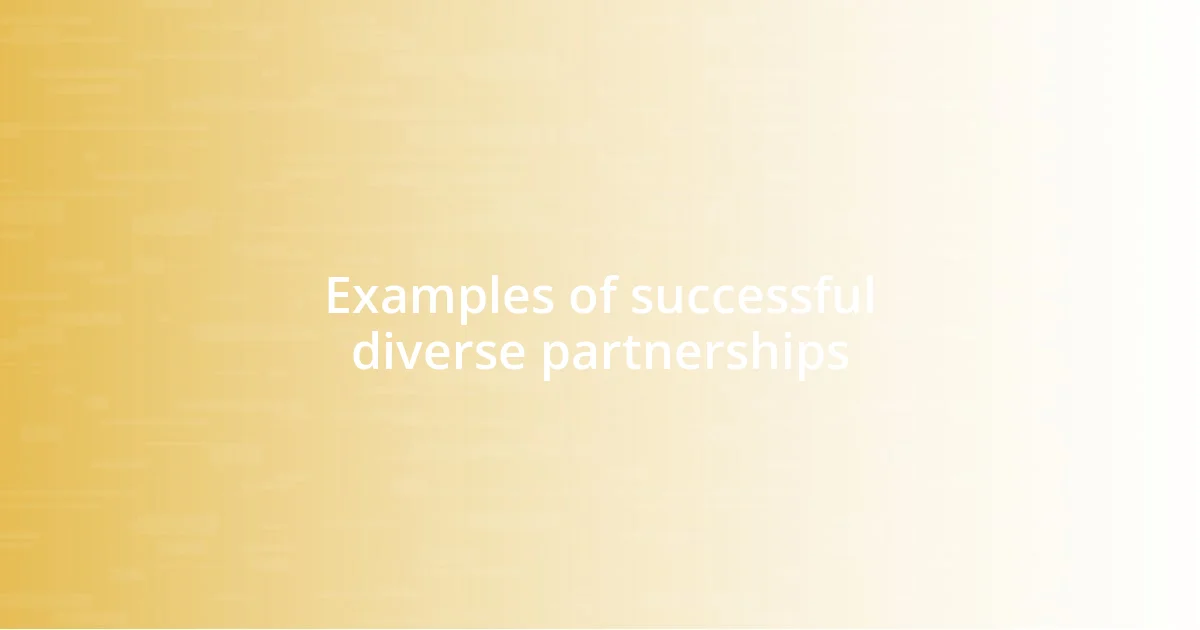
Examples of successful diverse partnerships
One shining example of a successful diverse partnership came when I collaborated with a group of artists from varying cultural backgrounds for a community mural project. Each artist brought their unique perspective, and as we painted together, I felt an incredible energy flowing through our discussions. It struck me how our differences not only enriched the artwork but also deepened our understanding of the community we aimed to represent. Have you ever been part of something that made you see the world through someone else’s eyes?
In another instance, I joined forces with a tech start-up led by individuals from different demographics to design an app aimed at improving accessibility for individuals with disabilities. The diverse inputs ensured that we considered features that truly met the needs of our users. As we navigated various viewpoints and ideas, I realized that the richness of our discussions propelled us towards solutions that were more innovative and inclusive. When was the last time you felt that the blending of ideas sparked something extraordinary?
A more personal experience was when I partnered with a local nonprofit organization focused on environmental sustainability. By collaborating with community members from various backgrounds, we developed a series of workshops that addressed environmental issues in culturally relevant ways. This partnership not only generated impactful learning experiences but also fostered a sense of belonging and ownership among participants. It’s amazing how diversity can transform ordinary initiatives into meaningful movements; have you experienced that kind of transformation in your own work?

Future trends in diverse partnerships
Diverse partnerships are likely to evolve with an increasing focus on technology-driven collaborations. For instance, I recently participated in a virtual summit where diverse teams from around the globe worked together on sustainability initiatives. The experience opened my eyes to how geographical barriers are fading, and I can’t help but wonder: how might technology further bridge these gaps in the future?
In addition, I anticipate a surge in partnerships that prioritize social impact over profit. I’ve seen firsthand how organizations are reshaping their missions to incorporate community well-being into their core strategies. Shouldn’t we all consider how our collaborations can leave a lasting legacy, rather than just a financial report? This shift will likely inspire new frameworks for partnerships that truly reflect the values of all stakeholders involved.
Moreover, the trend of incorporating holistic measures of success is gathering momentum. I recently engaged in a workshop that explored metrics like emotional intelligence and community satisfaction, and I found it refreshing. Have you ever thought about how deeply these aspects could influence a partnership’s trajectory? By redefining what success looks like, we can create collaborations that not only achieve goals but also foster genuine connections and lasting change.










